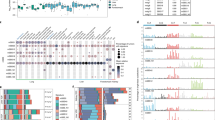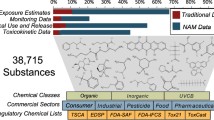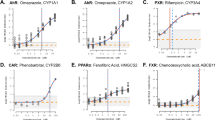Abstract
RAPID and reliable screening methods are required for identifying environmental mutagens and estimating their mutagenic potency in preparation for use of more elaborate tests to assess the genetic risk to man. Many compounds are effectively screened by in vitro mutagenesis assays using either bacterial or mammalian cells. Although tests with mammalian cells are not as rapid and inexpensive as microbial assays, they are needed to confirm and extend the bacterial results, and probably provide a better assessment of potential risk to humans than do microbial tests. However, the screening of all potential mutagens with mammalian cell mutagenicity assays, although desirable, does not seem feasible unless, as we propose, test compounds are first pre-screened on the basis of their cytotoxic potency. On theoretical grounds, one expects a certain minimum cytotoxic potency to correlate with mutagenic potency, particularly when the latter is measured using forward mutations that result in inactive gene products. Specifically, cells cannot divide unless a substantial fraction of their genome is functionally intact; mutagenic agents should thus be obligatory cytotoxic agents, with a given mutagenicity conferring a certain irreducible cytotoxicity. We show here that the cytotoxic potency of 22 chemical mutagens is highly correlated with their mutagenic potency as assayed in five rodent and human in vitro cell systems. This relationship implies that the maximum potential mutagenic potency of such compounds may be reliably estimated from rapid and straightforward measurements of their cytotoxic potency, the latter defined as the failure of cultured cells to undergo continued cell division. The estimate is necessarily a maximum one, as an agent may exert cytotoxic effects by pathways independent of its mutagenic action.
This is a preview of subscription content, access via your institution
Access options
Subscribe to this journal
Receive 51 print issues and online access
$199.00 per year
only $3.90 per issue
Buy this article
- Purchase on Springer Link
- Instant access to full article PDF
Prices may be subject to local taxes which are calculated during checkout
Similar content being viewed by others
References
Thacker, J., Stretch, A. & Stephens, M. A. Mutat. Res. 42, 313–326 (1977).
Chadwick, K. H., Leenhouts, H. P., Szumiel, I. & Nias, A. H. W. Int. J. Radiat. Biol. 30, 511–524 (1976).
Parodi, S. & Brambilla, G. Mutat. Res. 47, 53–74 (1977).
Munson, R. J. & Goodhead, D. T. Mutat. Res. 42, 145–160 (1977).
Roberts, J. J. in Advances in Radiation Biology (eds Lett, J. T. & Adler, H.) 212–436 (Academic, New York, 1978).
Roberts, J. J., Sturrock, J. E. & Ward, K. N. in Chemical Carcinogenesis Part A (eds Ts'o, P. O. & Dipaolo, J. A.) 401–425 (Marcel Dekker, New York, 1974).
Carver, J. H., Wandres, D. L., Adair, G. M. & Branscomb, E. W. Mutat. Res. 53, 96–97 (1978).
Carver, J. H., Dewey, W. C. & Hopwood, L. E. Mutat. Res. 34, 465–480 (1976).
Couch, D. B. & Hsie, A. W. Mutat. Res. 57, 209–216 (1978).
Couch, D. B., Forbes, N. L. & Hsie, A. W. Mutat. Res. 57, 217–224 (1978).
Hsie, A. W., Brimer, P. A., Mitchell, T. J. & Gosslee, D. S. Somatic Cell Genet. 1, 247–261 (1975).
Jones, G. E. & Sargent, P. A. Cell 2, 43–54 (1974).
Molnar, S. J. & Rauth, A. M. Mutat. Res. 41, 361–376 (1976).
O'Neill, J. P., Fuscoe, J. C. & Hsie, A. W. Cancer Res. 38, 506–509 (1978).
Abbondandolo, A. et al. Mutat. Res. 37, 293–306 (1976).
Arlett, C. F., Turnbull, D., Harcourt, S. A., Lehmann, A. R. & Colella, C. M. Mutat. Res. 33, 261–278 (1975).
Bhuyan, B. K., Peterson, A. R. & Heidelberger, C. Chem.-Biol. Interactions 13, 173–179 (1976).
Davies, P. J. & Parry, J. Genet. Res. 24, 311–314 (1974).
Duncan, M. E. & Brookes, P. Mutat. Res. 21, 107–118 (1973).
Huberman, E. Mutat. Res. 29, 285–291 (1975).
Huberman, E., Aspiras, L., Heidelberger, C., Grover, P. L. & Sims, P. Proc. natn. Acad. Sci. U.S.A. 68, 3195–3199 (1971).
Huberman, E. & Sachs, L. Proc. natn. Acad. Sci. U.S.A. 73, 188–192 (1976).
Kuroki, T., Drevon, C. & Montesano, R. Cancer Res. 37, 1044–1050 (1977).
Newbold, R. F. & Brookes, P. Nature 261, 52–54 (1976).
Peterson, A. R. et al. Mutat. Res. 36, 345–356 (1976).
van Zeeland, A. A. & Simons, J. W. I. M. Mutat. Res. 35, 129–138 (1976).
Wild, D. Mutat. Res. 31, 197–199 (1975).
Clive, D., Flamm, W. G., Machesko, M. R. & Bernheim, N. J. Mutat. Res. 16, 77–87 (1972).
Cole, J. & Arlett, C. F. Mutat. Res. 34, 507–526 (1976).
Cole, J. & Arlett, C. F. Mutat. Res. 50, 111–120 (1978).
Frantz, C. N. J. Tox. envir. Hlth 2, 179–187 (1976).
Albertini, R. J. & DeMars, R. Mutat. Res. 18, 199–224 (1973).
Cox, R. & Masson, W. K. Mutat. Res. 37, 125–136 (1976).
Jacobs, L. & DeMars, R. Mutat. Res. 53, 29–53 (1978).
Kuroda, Y. Jap. J. Genet. 49, 389–398 (1974).
Kuroda, Y. Mutat. Res. 30, 229–238 (1975).
Maher, V. M., McCormick, J. J., Grover, P. L. & Sims, P. Mutat. Res. 43, 117–138 (1977).
Maher, V. M., Ouelette, L. M., Curren, R. D. & McCormick, J. J. Nature 261, 593–594 (1976).
Penman, B. W. & Thilly, W. G. Somatic Cell Genet. 2, 325–330 (1976).
Thilly, W. G., Deluca, J. G., Hoppe, H. IV & Penman, B. W. Mutat. Res. 50, 137–144 (1978).
Williams, J. I. & Cleaver, J. E. Biophys. J. 22, 265–279 (1978).
Aaron, C. S., van Zeeland, A. A., Mohn, G. R. & Natarajan, A. T. Mutat. Res. 50, 419–426 (1978).
Bradley, M. O. & Sharkey, N. A. Nature 274, 607–608 (1978).
Author information
Authors and Affiliations
Rights and permissions
About this article
Cite this article
CARVER, J., HATCH, F. & BRANSCOMB, E. Estimating maximum limits to mutagenic potency from cytotoxic potency. Nature 279, 154–156 (1979). https://doi.org/10.1038/279154a0
Received:
Accepted:
Published:
Issue Date:
DOI: https://doi.org/10.1038/279154a0
This article is cited by
-
In situ genotoxicity assessment in freshwater zooplankton and sediments from different dams, ponds, and temporary rivers in Tunisia
Environmental Science and Pollution Research (2019)
-
MLL Gene Rearrangement in Acute Myelogenous Leukemia After Exposure to Tegafur/Uracil
International Journal of Hematology (2002)
Comments
By submitting a comment you agree to abide by our Terms and Community Guidelines. If you find something abusive or that does not comply with our terms or guidelines please flag it as inappropriate.



